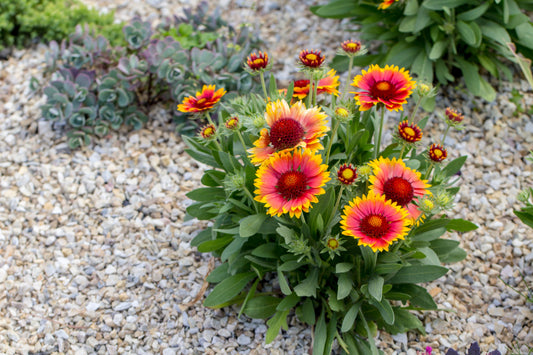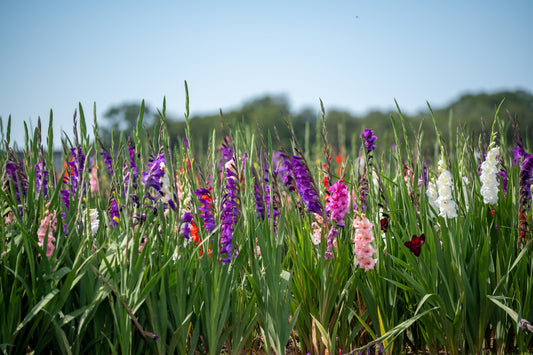Geranium Perennials Planting & Growing Guide
Planting Guide Information
-
Crown at soil linePlanting Depth
-
18" ApartPlanting Proximity
-
SpringPlanting Season
-
Hardy perennial plants.Plant Benefits
-
ModerateWater Quantity
-
SummerBloom Season
-
Full to Partial SunSunlight Quantity
-
Zones 5-8Hardiness Zones
Additional Growing Information
Where to Plant
Site your Geraniums where the soil drains well and they will receive partial sun to medium shade. If you notice puddles of water 5–6 hours after a hard rain, scout out another site or amend the soil with organic material to raise the level 2–3 inches. While Geraniums aren't fussy about soil, they will not survive in soggy soil or standing water. Once established, these plants can tolerate moderate drought.
When to Plant
The ideal time to plant Geraniums is in the spring after the danger of frost has passed. Expect top growth and additional roots to form within a few weeks of planting, depending on the soil and air temperatures. Flowers will emerge from late spring into summer.
How to Plant
- For outdoor landscape planting, find a spot where the soil drains well, and your Geraniums will receive partial sun to medium shade. Dig holes and tuck the roots into the soil, pointing downwards and fanned out. Place the growing points at the soil level, and space the plants about 12" apart.
- For container planting, select a vessel large enough to accommodate the mature size of your plants and fill it with good quality, well-drained soil—almost any commercially available potting medium will work fine. Ensure there are adequate drainage holes in your pots, as Geraniums must never sit in waterlogged soil. Dig holes and tuck the roots into the soil, pointing downwards and fanned out. Place the growing points at the soil level, and space the plants about 12" apart.
- Water thoroughly after planting, soaking the soil to settle it around the roots.
How to Grow
- Water periodically during the growing season if rain does not occur, keeping in mind that weekly deep waterings are better than lighter drinks every day or two. About 1" of water per week is a reasonable estimate of the amount needed during active growth periods.
- Trim the plants back 25 to 50% after the early flush of blooms has faded to tidy their shape and encourage another burst of color.
- Cut off any remaining leaves in late fall when the foliage begins to fade and wilt with the onset of colder weather.
- Divide the large Geranium clumps in the fall every third or fourth year by slicing them in half vertically with a sharp shovel.
- Replant the divisions or share with friends.
Geranium Tips & Tricks
- Amend the soil with compost, finely ground bark, or decomposed manure to improve the drainage as needed.
- Consider adding other plants to your container for variety, such as small to medium Hostas or tuberous Begonias.
- Provide some shade for your Geraniums—unless you're growing Sanguineum, which will tolerate full sun in northern regions.
- Expect your Geraniums to arrive potted or "bare root," meaning the plant is in a dormant state and the soil has been washed from the roots, so you won't risk introducing any soil-borne diseases into your garden.
- Bear in mind that next spring will bring new growth after cutting off the foliage in the fall.
From the Family
-
 15% OffPreorder
15% OffPreorderGeranium - Tapestry Mix (Perennial)
6 Geranium bareroots, mixedRegular price $25.47Sale price $25.47 Regular priceUnit price per$29.9515% OffPreorder -
 15% OffPreorder
15% OffPreorderGeranium - Kashmir Purple (Perennial)
3 Geranium barerootsRegular price $12.71Sale price $12.71 Regular priceUnit price per$14.9515% OffPreorder -
 15% OffPreorder
15% OffPreorderGeranium - Biokovo (Fragrant Perennial)
3 Geranium barerootsRegular price $12.71Sale price $12.71 Regular priceUnit price per$14.9515% OffPreorder -
 15% OffPreorder
15% OffPreorderGeranium - Wargrave Pink (Perennial)
3 Geranium barerootsRegular price $12.71Sale price $12.71 Regular priceUnit price per$14.9515% OffPreorder -
 15% OffPreorder
15% OffPreorderGeranium - Patricia (Perennial)
3 Geranium barerootsRegular price $12.71Sale price $12.71 Regular priceUnit price per$14.9515% OffPreorder








